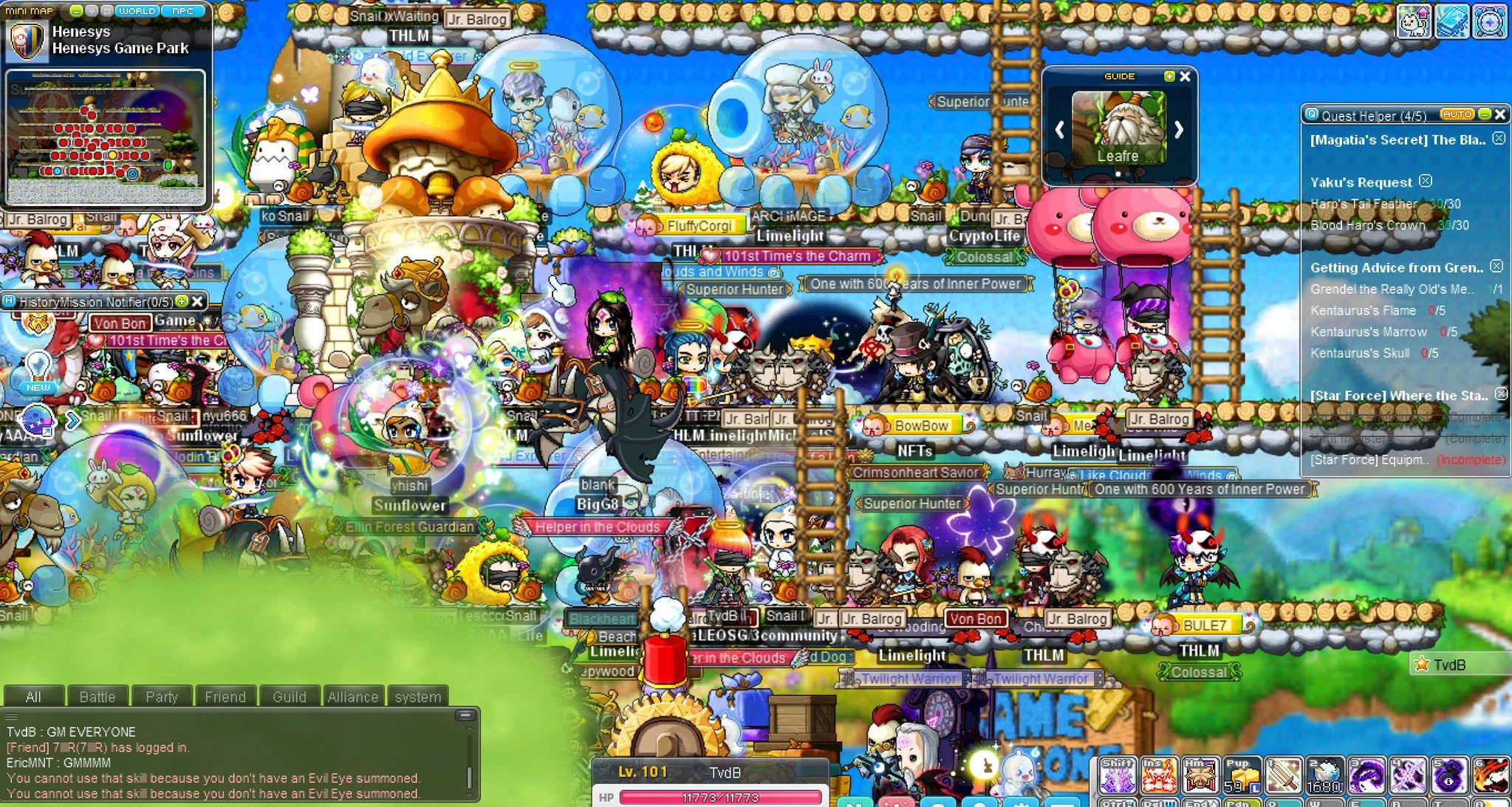After two years of waiting, the public beta and TGE of the blockchain version of MapleStory (hereinafter referred to as MSU) are finally coming. This is the largest traditional game in the blockchain field so far, with more than 20 years of operation, total revenue of more than 5 billion US dollars, and a total number of players exceeding 250 million. (For more background details about the game, please refer to: MapleStory + NFT, a classic game with more than 180 million registered players, why choose to go on the blockchain? )

Last week, MSU officially released the white paper of the game token $NXPC, which elaborated on the game economic mechanism of the blockchain version of MapleStory. This article will sort out the content of the white paper in detail, and let us take a look at how traditional online game brands design a set of Web3 game economic mechanisms.

1 asset in 3 different forms
MSUs economic system consists of $NXPC, $NESO and NFT, all of which can be exchanged in both directions.
$NXPC - is the native token used to pay MSU Layer 1 network gas fees, and can also be exchanged for $NESO or NFT.
$NESO - used for various functions in the game (such as weapon enhancement, etc.), can also be exchanged for $NXPC or used to purchase items on the official NFT market.
NFT – In-game characters, equipment, and consumables will appear in the form of NFTs, which can be exchanged with $NXPC in both directions, or traded with $NESO on the official market.
This does not mean that MSU adopts a dual or triple token model. In fact, the entire economic mechanism is 3 different forms of 1 asset.
If we regard in-game props as a kind of token, then in the original MapleStory and even most MMORPG games, this token is a bit like Ethereum - there is no upper limit on the supply, it rewards contributors (props dropped by monsters in the game), and there are burning channels (low-level props may be consumed through channels such as prop synthesis).
The similarities also exist in that in-game props can be subject to cyber attacks, and the intervention of the studio will greatly accelerate the output of in-game props, making the inflation of props serious.
In MSU, the source of all assets is $NXPC. The in-game currencies $NESO and $NXPC have a fixed exchange rate and can only be exchanged and minted with $NXPC. All game props (NFT), such as weapons, armor, and decorative items, are centrally managed by the official in MSU and stored in the official MSU Item Pool. For these props to enter circulation, they need to be exchanged with $NXPC.
$NESO and game props (NFT) will not be dropped in the game, but this does not mean that they are independent assets, and their source is also $NXPC:
NESO can only be minted through NXPC. Due to the fixed exchange rate, the theoretical maximum supply of $NESO is the same as $NXPC.

MapleStory N receives $NXPC as an ecosystem contribution reward, and may convert some of the $NXPC into NFTs as in-game rewards. Players can obtain NFTs through various in-game activities including killing monsters and beating bosses.
It can be said that $NXPC is like liquid water, and $NESO is like ubiquitous water vapor, which is needed in all aspects of the game, especially weapon enhancement, which can help players improve their combat power and better fight monsters, upgrade, and obtain props in the game. NFT is like solid ice, and its liquidity is much worse than FT. As weapons are enhanced, the price of the same equipment will also differ.
$NXPC fission and item fusion
The $NXPC fission mechanism means that players can use $NXPC to redeem game props (NFT). This mechanism is very similar to the FCFS (first come first served) process of buying NFTs. Players do not redeem a specific prop, but a fixed percentage of the maximum supply of all available prop types in the MSU Item Pool.
The exchange rate between $NXPC and NFT will be fixed, and will only rise when new items appear in future game updates and enter the MSU Item Pool. Exchanging NFT will not lead to the destruction of $NXPC.
The Item Fusion mechanism is a bit like the NFT market has a bid pool. If players want to sell their props (NFT) quickly, they can directly put it into the pool. However, players do not choose their own quotes on the official market and accept the settlement of income in the in-game currency $NESO. The official will capture the corresponding prop prices in the secondary market and take the median of the weighted average price to determine how much $NXPC the player can get.

These two mechanisms make the whole game very GameFi-like. In fact, the blockchain version of MapleStory is likely to have no in-game store, nor a traditional in-app purchase store such as the Point Store. Instead, it will be replaced by a unified consumer asset $NXPC - either use $NXPC to redeem items, or use $NXPC to convert into $NESO to purchase on the official NFT market (this situation will appear more often on enhanced premium items with better properties).
If $NXPC is used to redeem items, players will be forced to buy items they do not need. One benefit of this is that it will promote the overall liquidity of items (such as items for unpopular professions, items with low rarity, and items with low attributes, etc.).
The ideal effect is to step on the right foot with the left foot - players use $NXPC to redeem props to improve the efficiency of obtaining advanced items in the game -> $NXPC price rises -> the returns obtained from item fusion (gold farming) increase -> more $NXPC is bought and reinvested in gold farming.
But the relatively bad part is that the strong GameFi flavor may cause a certain attenuation of the fun and diversity that the game itself can bring. Because of the value anchor of $NXPC, coupled with the particularity of blockchain users themselves, even with the special mechanism of $NXPC fission to avoid certain specific props from being extremely hyped and most props from being worthless, players will still choose the profession that is easiest to grow in the game (such as having group attack skills to destroy monsters in a map the fastest, or relatively easy to upgrade) in order to maximize $NXPC benefits. Many maps, tasks and dungeons that are not cost-effective for game behaviors such as upgrading may be even less popular, resulting in a significant impact on the diversity of the game. If the item fusion mechanism is monopolized by a studio, it is likely to lead to insufficient consumption power for the game as a whole.
But in any case, from the perspective of game profitability, this is indeed a very bold attempt. MapleStory originally made money by selling in-game items such as costumes and enhancement scrolls, but this blockchain version has no in-game purchases at all, and everything depends on the value of $NXPC. The output of in-game coins ($NESO) and props (NFT) is also regulated by $NXPC.
$NXPC
The total supply of $NXPC is 1 billion. 80% is used for MSU ecological contribution rewards. Of the remaining 20%, 16.317% is airdropped to the early community, 0.437% is used for liquidity provision, 0.15% is used to waive gas fees, and a total of 16.904% is fully unlocked at TGE.
Of the remaining 3.096%, 2% goes to the IP licensor and 0.696% goes to the MSU team. These two parts are locked for 9 months and unlocked quarterly over the next 3 years. 0.4% goes to the consultants, which is locked for 12 months and then unlocked depending on the development of the project.
Conclusion
Since the birth of GameFi, the discussion about playability and finance has never stopped. If a truly good game appears in the cryptocurrency circle, will GameFi escape the death spiral? MapleStory may give an answer to this question with its own performance.
In addition, MapleStory is an MMORPG game where social fun > exploration fun (personal opinion only). When the audience turns to the cryptocurrency circle (blockchain special edition), will the social fun of the game and the resulting powerful fission communication ability change? This question also makes me very curious and looking forward to it.
But there is no doubt that this is really a good game, and it can make the cryptocurrency world happier.










